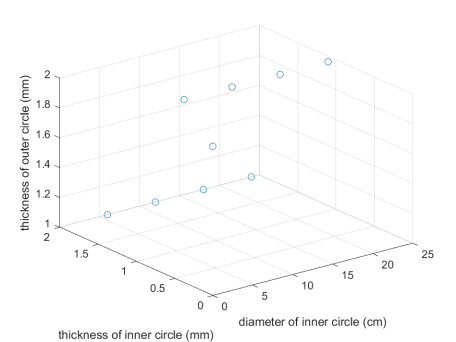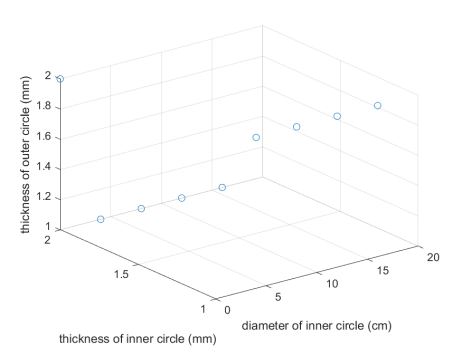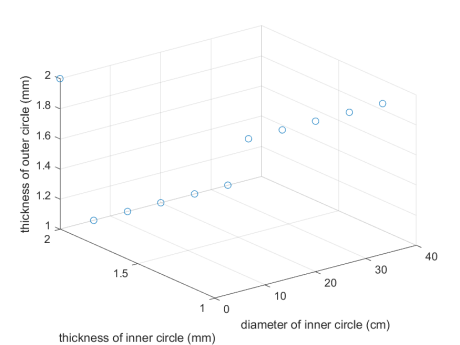1.Introduction
Sound is a fundamental natural phenomenon and a vital communication tool. Continuous research has deepened our understanding, enabling precise descriptions using physical principles. Drums, with their rhythmic and deep tones, are essential in music. However, as music evolves, traditional drums face sound quality limitations, hindering their integration into modern compositions.
This project aims to enhance drum tonal performance and advance music technology by enabling two tones from a single drum. It seeks to drive tonal innovation, diversify music, and offer insights for modernizing traditional instruments.
Improving drum sound quality and achieving two tones from a single strike require understanding sound generation. Drum sound [1] originates from head vibrations, exciting multiple frequency modes. At the fundamental frequency, pronounced vibrations alter air pressure, interacting with the drum’s acoustic resonance to amplify sound, which then propagates and is perceived.
Drumhead pretension [2] is crucial for uniform material properties and accurate tuning. Low tension causes uneven rigidity, leading to non-uniform vibrations and variable resonance frequencies. Since stiffness directly affects resonance and sound frequency, proper tension ensures consistent and precise tones.
The bass drum, one of the loudest orchestral instruments, has a batter head tuned higher than the resonant head, creating peaks at membrane vibration modes [3]. Low tension and air coupling cause significant frequency differences between in-phase and out-of-phase motions, with faster decay when both heads are equally tensioned. Fletcher analyzed bass drum frequencies and harmonics, finding proportional frequency changes with decreasing amplitude [4]. He later synthesized bass drum tones, showing striking location affects sound [5]. Listening tests found synthetic tones indistinguishable from real ones 51% of the time, validating his method.
Crawford explored tuning drum overtones through membrane inhomogeneities [6], finding that only the first two overtones—a perfect fifth and an octave—can be tuned, expanding orchestral drum possibilities. Future progress depends on 3D-printed membranes and musicians' acceptance. However, generating two distinct tones from a single strike remains challenging due to limitations in controlling vibrational modes and overtones. Further research is needed to develop techniques or designs for multiple tones per strike, enhancing drum expressiveness and sound color.
This report is structured as follows: Section 1 covers membrane vibration theory and its role in drum sound generation. Section 2 presents pre-experiments to exclude factors with minimal sound impact. Section 3 compares traditional and modified drums, analyzing how structural changes affect tone and quality. Section 4 concludes with key findings and future research directions.
2.Pre-Experiment: Eliminating the Influence of Certain Variables
This section examines parameters affecting drum tones, primarily membrane vibration. The two key factors influencing natural frequency are mass and stiffness. Three elements are analyzed: drumhead material, diameter, and pretension/thickness.
Drumhead diameter affects mass—larger surfaces increase mass, altering vibration dynamics and sound. Pretension and thickness influence both mass and stiffness, with pretension affecting stiffness and thickness impacting both. Different materials have varying elastic moduli, requiring different forces for the same deformation level.
2.1.Determination of the pretension on the membrane deformation
To investigate pretension's impact on membrane deformation and its manual application, finite element analysis (FEA) was conducted using a 40 cm TPU membrane (0.3 mm thickness) with properties from [7].
A 1 mm diameter hole was placed at the membrane's center to simulate fixation. The simulation fixed this hole, representing a scenario where a nail secures the membrane to a table. The mesh settings for this model are shown below (Mesh image).
A 2 mm displacement was applied at the membrane's edge to determine the force required for deformation. As seen in the graph (displacement + force image), a 15 N force caused a 2 mm displacement. However, the stress at the hole reached 122 MPa, which could damage the fixation point. Despite this risk, nails were used in practical testing to secure the membrane to the drum body.
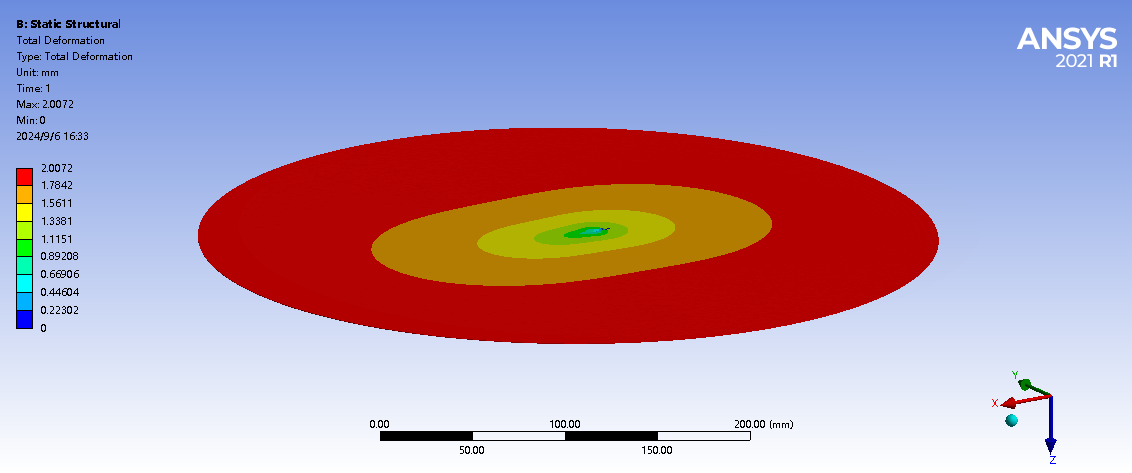
Figure 2.1: typical deformation shape when subject to a pretension of 15N
2.2.Material and Test Apparatus Preparation
In this experiment, three drum body diameters—20 cm, 30 cm, and 40 cm—were selected to represent typical drum sizes and ensure significant frequency differences, fulfilling the experimental requirement for varied frequency outputs. Two membrane materials, thermoplastic polyurethane (TPU) and rubber, were chosen for their availability, affordability, and elasticity, which are crucial for examining the impact of pretension on the drumhead. Only two levels of pretension were tested due to high stress concentration at fixation points. With just a 2 mm displacement, the stress can exceed 122 MPa (see Figure 2.2), and further tension could lead to membrane breakage.
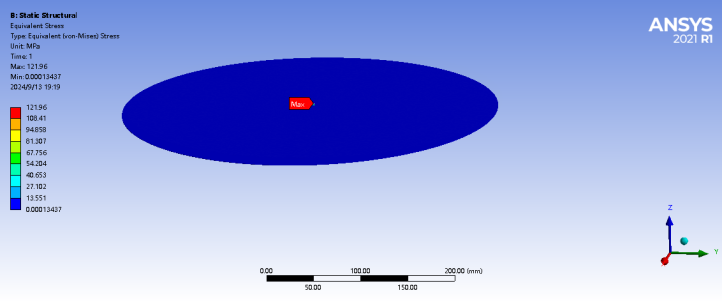
Figure 2.2: maximum stress with a 2 mm displacement
In the material and apparatus preparation phase, the independent variables were drum body diameter, drum head pretension, and material. Three drum body diameters were used, with smaller diameters corresponding to higher membrane tension. TPU and rubber were selected for their elasticity and impermeability, and pretension was assessed qualitatively due to challenges in measuring exact tension on a 2D membrane.
The apparatus used in this experiment included drum bodies of various diameters, drum heads made from different materials, a drumstick, sound-collecting devices, and a ruler. The combinations of drum bodies and drum heads used in this experiment are shown in Figure 2.3.
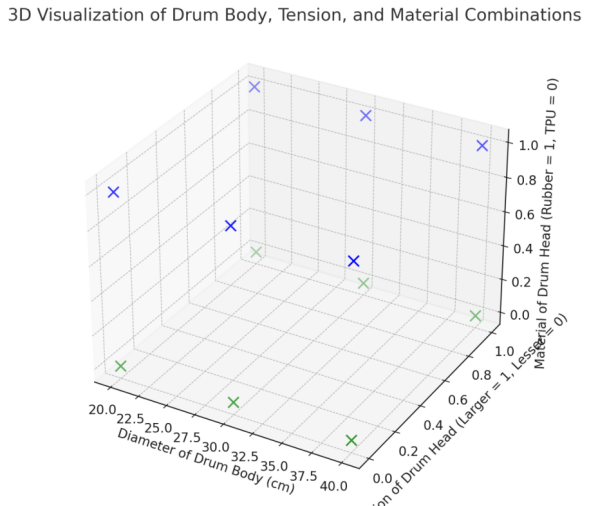
Figure 2.3: descriptions of different combinations for the measurements
In addition to the mass and stiffness of the drum head, the air pressure inside the drum body can affect the sound frequency. To control this, a hole was made in the drum body to equalize the internal air pressure with the barometric pressure.
For the experiment, three microphones were positioned at trisection points of a circle around the drum to account for directional sound variations. Each microphone was oriented differently: one obliquely upwards at a 45-degree angle, one downwards at a 30-degree angle, and one horizontally aligned with the surface. All microphones were placed 12 cm above the drum head.
Condenser microphones connected to a signal conditioner captured the sound, which was then sent to a computer for analysis. An example setup is shown in Figure 2.4.
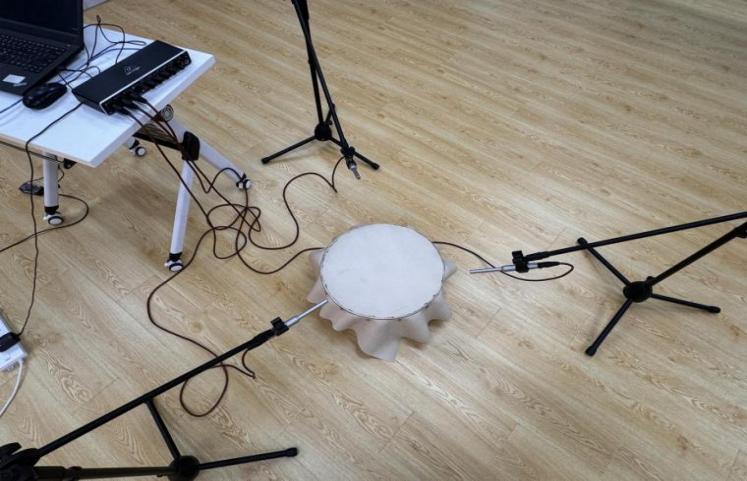
Figure 2.4: overview of the setup
For each combination, the drumstick strikes the center of the drum head 100 times, with recordings saved every 10 beats to maintain consistent force. Sound data (time and amplitude) are captured using sound-collecting devices. The results are averaged using an ensemble technique to reduce noise and emphasize low-frequency tones, ensuring a consistent sound curve despite hitting position variations.
Audio recordings from three microphones are processed at 44,100 Hz in Adobe Audition, with mono tracks. The key variables are drum body radius, tension (linked to the radius), and material. For each recording, 10 hits are split, and 5 complete hits are selected. Fourier transform is applied to convert data into the frequency domain, and the average frequency spectrum is calculated. The main tone is identified by locating the peak frequency, and the effects of each variable are isolated using the control variable method.
2.3.Results and analysis
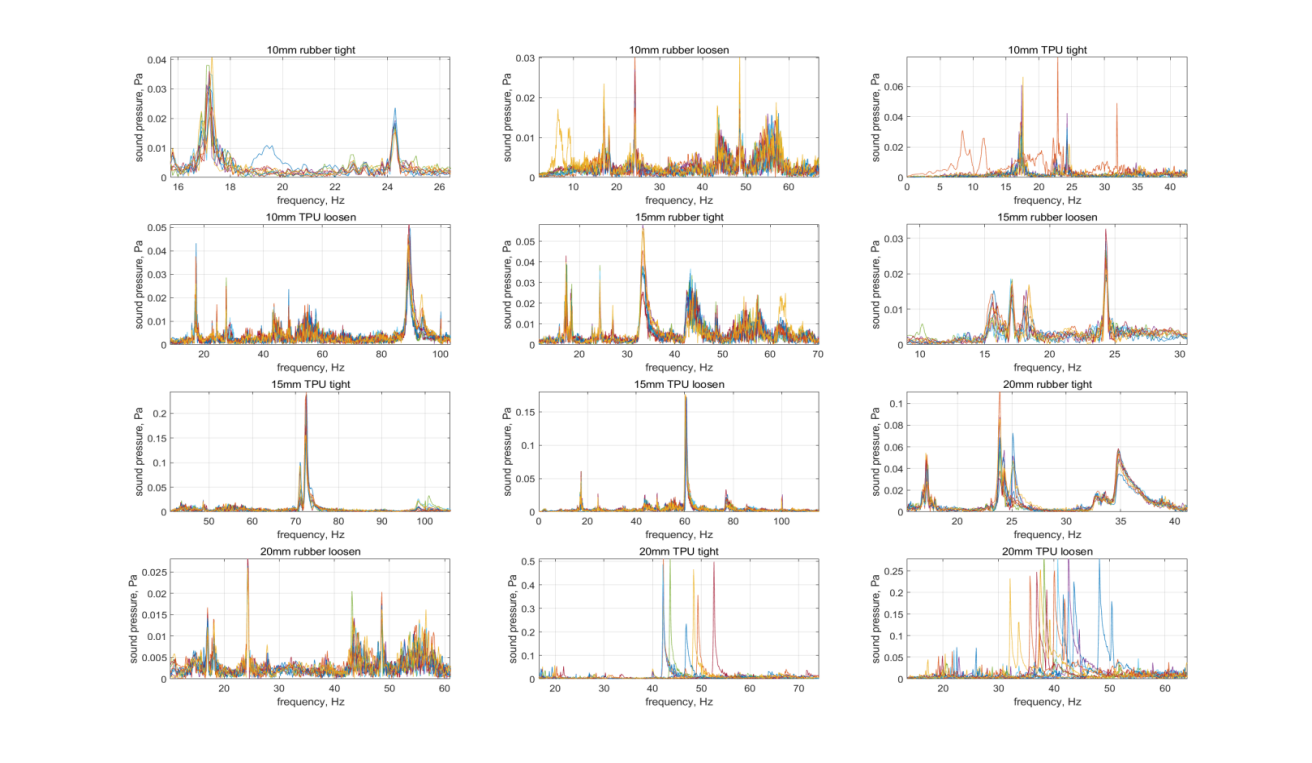
Figure 2.5: overview of sound spectrums of different drums
Figure 2.5 shows the repeatability of data from 10 strikes across 12 models, varying in drum head material (TPU and rubber), tension (tight and loose), and diameter (20 cm, 30 cm, and 40 cm). Each graph represents the frequency response and sound pressure for each model.
Abnormal points were excluded due to variations in strike location, especially for larger drum heads (40 cm), where inconsistent strikes can trigger different vibration modes, affecting repeatability.
The data shows high repeatability in most models, with consistent frequency responses across strikes. TPU drum heads exhibit sharper, more consistent peaks compared to rubber, especially in the "tight" configuration. Rubber heads, particularly in the "loosen" setup, show more variability due to higher energy dissipation, making them more sensitive to strike position.
For 20 cm membranes, TPU shows stable peaks, while rubber has scattered responses, especially in the "loosen" configuration. For 30 cm membranes, both rubber and TPU have peaks between 40 and 60 Hz, but TPU demonstrates better repeatability and sharper peaks between 60 and 90 Hz. The 40 cm membrane results show similar trends, with TPU maintaining stability while rubber shows increased noise and variability.
Overall, TPU drum heads provide clearer, more consistent sound, with less sensitivity to strike position. Rubber heads, especially in looser configurations, exhibit greater variability due to higher energy dissipation. These findings highlight the impact of material and tension on sound consistency, offering valuable insights for drum design.
3.Impact of local thickness variation on drum sound generation
In the pre-experiment phase, cowhide was excluded due to inconsistent stretching and varying stiffness, which hindered uniform pretension. TPU and rubber were selected for their more consistent properties. However, material changes alone could not produce two distinct tones from one strike. The focus shifted to modifying the membrane's moment of inertia by adjusting its thickness, which could excite multiple vibration modes and frequencies simultaneously.
While TPU was useful in other phases, it was too thin for physical modification. Rubber, though thick enough, had grindability issues and poor repeatability. Therefore, cowhide was chosen for its sufficient thickness, allowing local modifications to alter its physical properties. Thickness was prioritized because other parameters, such as pretension and stiffness, were challenging to control accurately, while thickness offered a more controllable way to influence the membrane's vibration characteristics and achieve the desired multiple tones.
3.1.Finite Element analysis
The objective of this section is to employ finite element analysis (FEA) to investigate whether locally altering the membrane's thickness can enable the generation of two distinct frequencies from a single strike. The cowhide selected for this analysis possesses specific properties that are detailed in Figure 3.1:

Figure 3.1: Material properties of the cowhide[7]
To simulate the effect of grinding the membrane, two cylindrical models were created with differing heights, representing the membrane's inner and outer sections after grinding. The inner cylinder has a greater height than the outer ring, as illustrated in Figure 3.2.
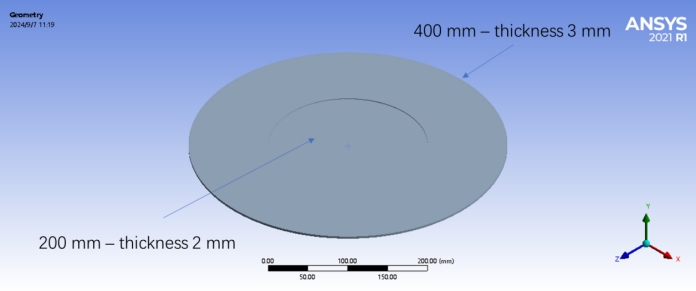
Figure 3.2: Geometry of the cylindrical disk with lower central thickness
The mesh settings for the model are also shown in Figure 3.3, where the mesh density is set to 4 mm.
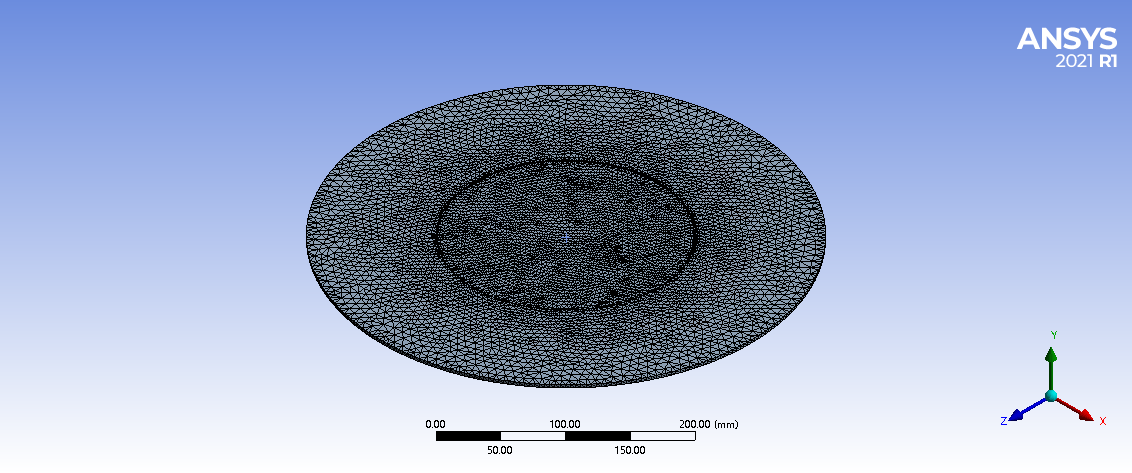
Figure 3.3: mesh density of cylindrical disk.
The boundary condition applied constrains the edges of the membrane, allowing nodes at the boundary to move horizontally but not vertically.
A second simulation used a uniform 40 cm diameter, 3 mm thick disc as a reference model, which was compared with a model featuring variable thickness across sections. The focus was on identifying resonance frequencies, indicating where the membrane vibrates most intensely, and examining differences in vibration patterns at these frequencies.
From the analysis, it was found that the membrane with uniform thickness exhibited a higher resonance frequency compared to the membrane that had been ground (see Figure 3.4).
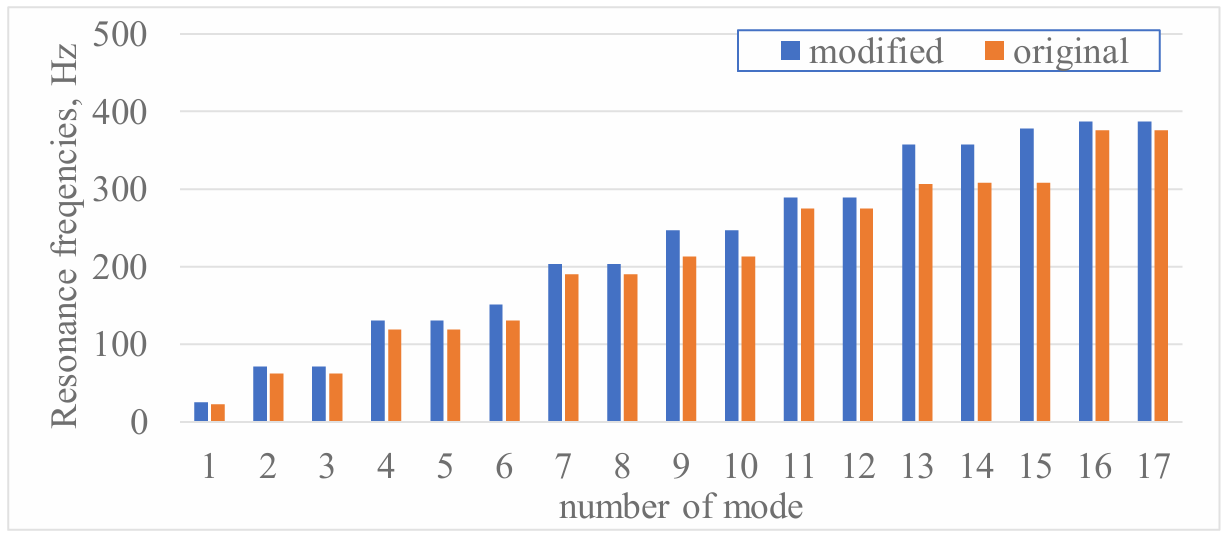
Figure 3.4: Comparison of the resonance frequencies for original and modified cowhide drum head
This difference can be attributed to the reduction in thickness, which lowers the stiffness of the membrane and, consequently, the resonance frequency.
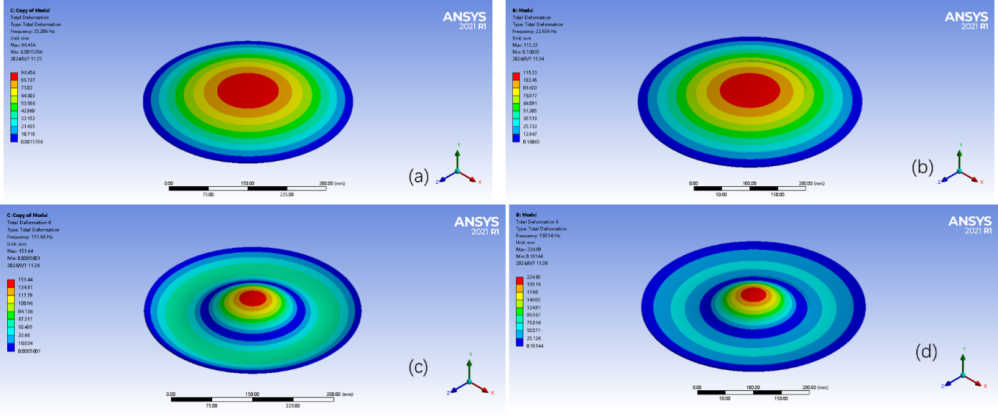
Figure 3.5: mode shape for two modes where the highest deformation occurs at the center of the drum head (a: original cowhide – mode 1; b: modified cowhide – mode 1; c: original cowhide – mode 2; d: modified cowhide – mode 2). In these graphs, the red areas represent regions of more intense vibration.
By comparing Figures 3.5(a) and (b), we observe a significant decrease in the first mode's frequency after grinding, though the vibration mode remains similar. For the second mode (Figures 3.5(c) and (d)), the frequency change is minimal, but the vibration mode alters, with reduced outer ring vibrations, indicating a decrease in the second resonance peak's amplitude after grinding.
This analysis reveals that while a drum can theoretically produce two distinct frequencies, energy decay to higher frequencies often prevents the excitation of the second mode. Local thickness modification can shift lower frequencies and increase the likelihood of exciting the second mode, but the grinding wasn't sufficient to reliably produce two distinct frequencies. Interestingly, this process appears to improve sound quality, possibly enhancing richness or clarity.
The potential for generating two distinct frequencies remains, especially with strategic strike placement. Striking the center excites only the first and fourth modes, while hitting one-quarter of the radius could excite the first, second, and third modes.
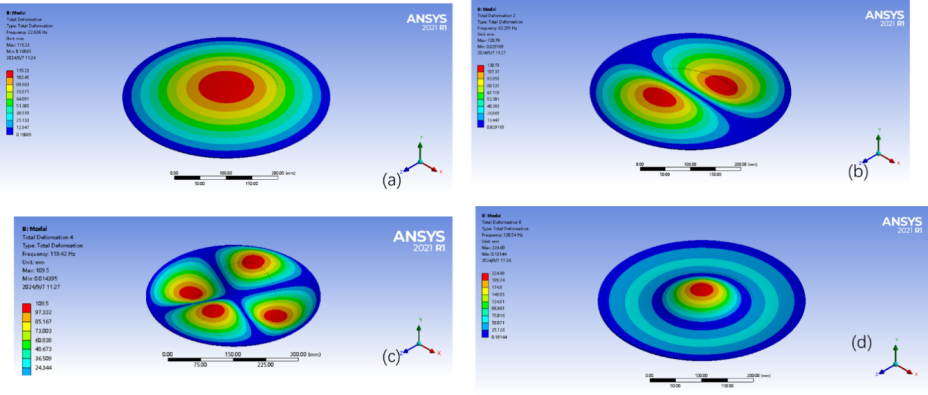
Figure 3.6: First four vibration mode shapes for a modified drum head
In this case, the sound quality could degrade, as exciting three non-harmonic frequencies might create noise-like effects. Modifying the thickness to selectively control the frequencies is a complex task, and current tools lack the precision needed. Instead of fine-tuning specific frequencies through structural changes, it may be more effective to use thickness variation to enhance the overall sound quality of the drum.
3.2.Experiment: Exploring the Influence of Thickness on Sound Quality
This section investigates how modifying the cowhide membrane's thickness affects the drum's sound quality. It includes material and apparatus preparation, and data processing and analysis. While data collection is similar to the Pre-Experiment phase, this phase focuses on sound quality changes rather than frequency. The material and apparatus preparation is detailed, with other methods following previous sections.
3.2.1.Material and Apparatus Preparation
In this phase, the focus was on evaluating how modifications to the cowhide membrane's thickness and design affect sound quality, particularly tone richness and clarity. Independent variables included the inner circle diameter, outer ring width, thickness, and drum body diameter. The width of the outer ring was calculated as the difference between the drum head diameter and the inner circle.
For 20 cm and 30 cm drum bodies, four different inner circle diameters and outer ring widths were selected, while for 40 cm drum bodies, five sizes were chosen. Two thickness options, 1 mm and 2 mm, were used for both the inner circle and outer ring.
The grinding process involved removing thin layers from the membrane, with thickness measured at multiple points and adjusted layer by layer. Circles were drawn to guide the grinding, and small adjustments were made to ensure even thickness, particularly for the outer ring.
Three drum body diameters—20 cm, 30 cm, and 40 cm—were chosen to study how the overall dimensions interact with the modified membranes to affect sound quality. Figure 3.7 illustrates the modified drum heads.
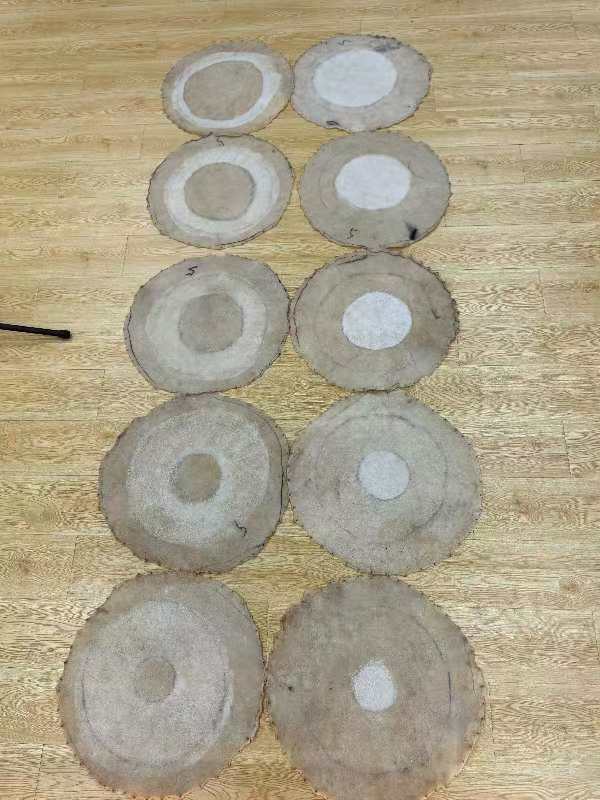
Figure 3.7: A photo of the modified cowhide as the drum head.
The various combinations of drum bodies and drum heads used in this experiment are summarized in Figure 3.8.
|
|
|
|
|
(a)20 cm |
(b) 30 cm |
(c) 40cm |
Figure 3.8: configuration of the drums with different local thickness
3.2.2.Data Collection and Analysis
The data collection and analysis procedures followed the same methods as in the Pre-Experiment phase. Strikes were made on the drum head with a drumstick, and sound data were captured by sound-collecting devices. Fourier transform techniques processed the recorded sound data, focusing on both frequency components and overall tonal qualities, such as richness and clarity.
The main analysis goal was to assess whether the membrane modifications, specifically the varying thicknesses of the inner circle and outer ring, led to improvements in sound quality. The analysis focused on harmonic content, peak clarity, and tone richness. Outliers and abnormal data points were excluded, using the same protocols as the Pre-Experiment phase.
3.3.Results and analysis
In this section, we examine the effect of varying local thickness on the sound generation characteristics of the modified drum head. The primary focus is on evaluating the repeatability of sound generation using different modification methods.
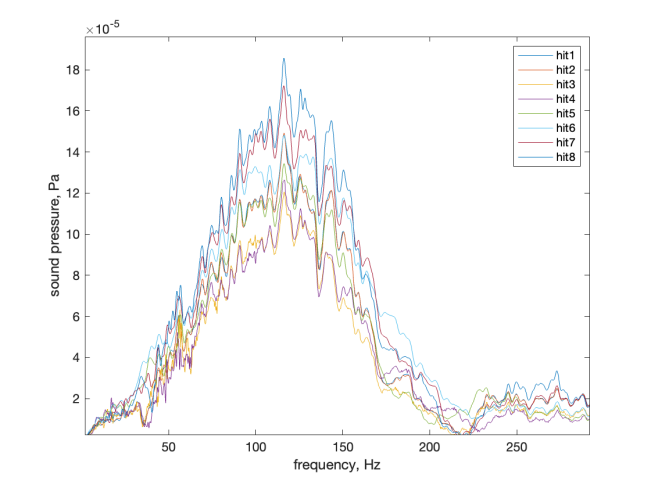
Figure 3.9: Comparison of the sound spectrum for the unmodified drum head subjected to multiple strikes (diameter = 20 cm)
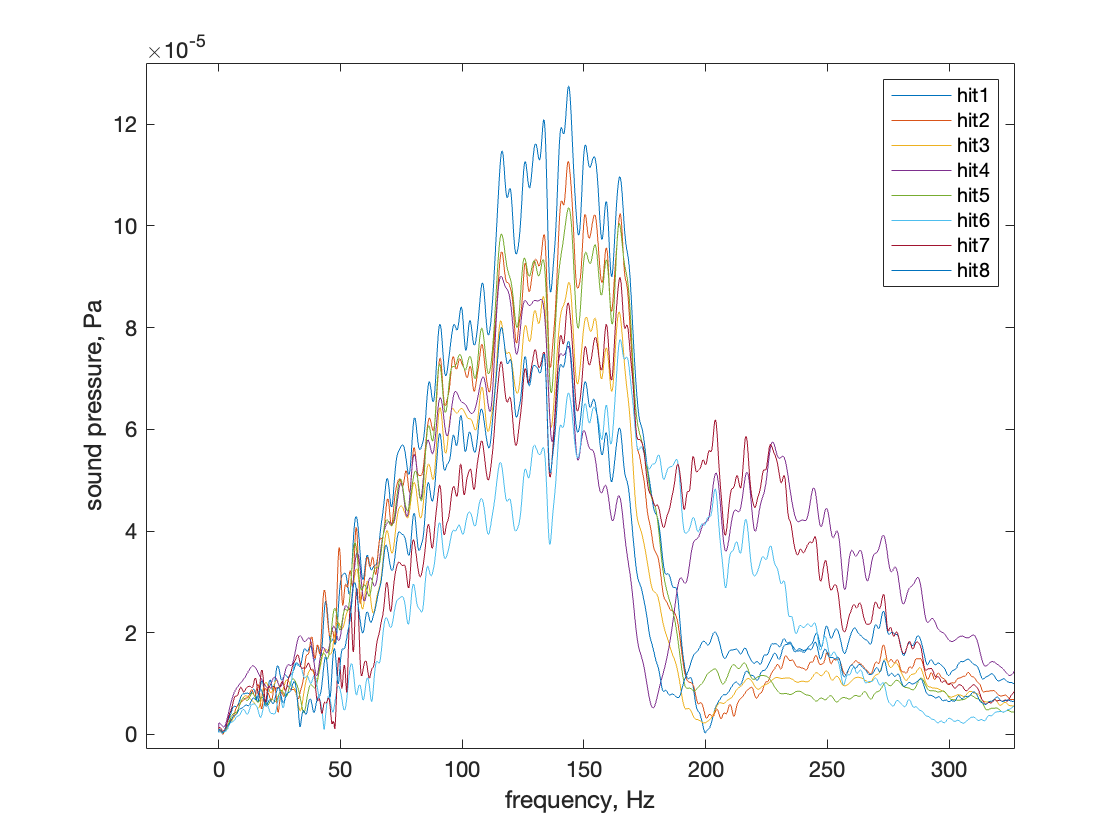
Figure 3.10: Sound spectrum for a drum head with reduced thickness at the inner circle (outer diameter = 20 cm, inner circle diameter = 4 cm).
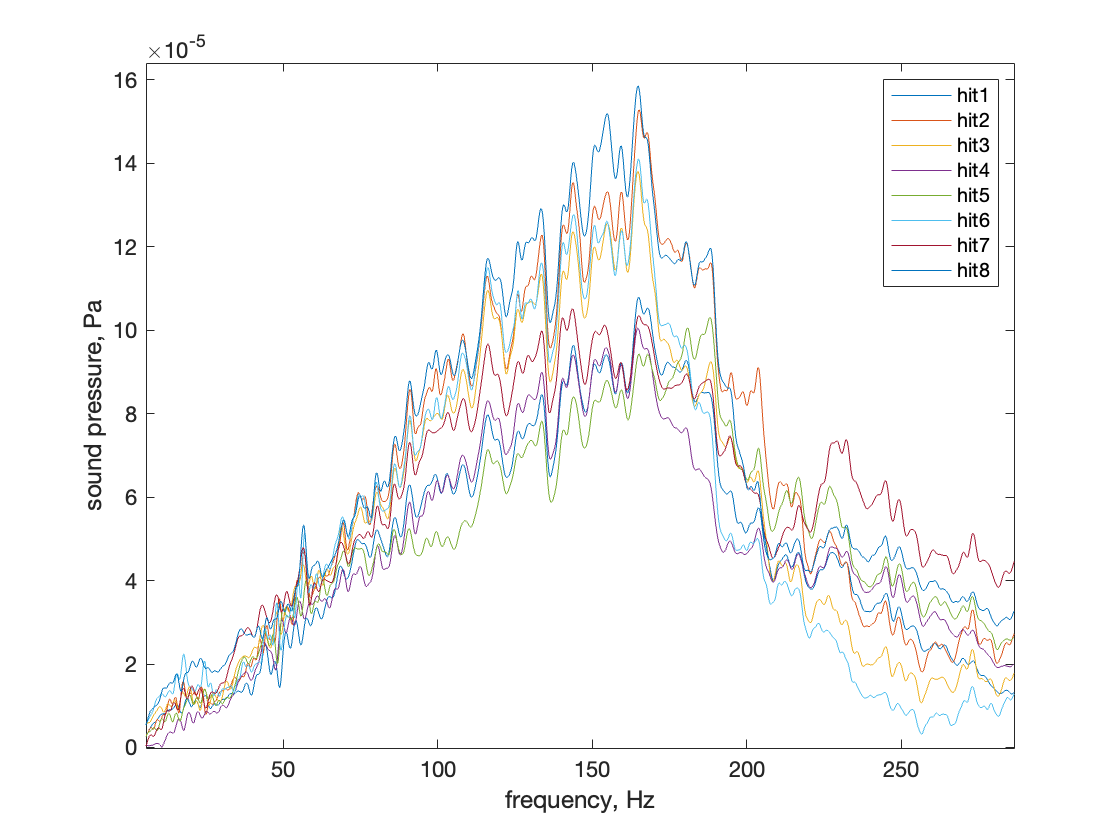
Figure 3.11: Comparison of the sound spectrum for a drum head with reduced thickness at the outer ring (outer diameter = 20 cm, inner circle diameter = 4 cm)
The results show that the reference and outer ring-modified drum heads demonstrate consistent repeatability, while the inner circle modification exhibits reduced repeatability, especially around 200 Hz. This variation can be attributed to the uneven grinding process, which affects the thickness distribution near the impact point, causing fluctuations in energy distribution and diminishing repeatability.
In the comparison of inner circle modifications with varying diameters (Figure 3.12), thinning the inner circle enhanced the prominence of the main peak, improving sound quality. However, as the radius of the thinned area increased, sound quality declined. The outlier in group 2 is likely due to variations in the strike position. Additionally, the increased peak around 200 Hz, which is double 100 Hz, indicates a stronger harmonic effect, enriching the timbre.
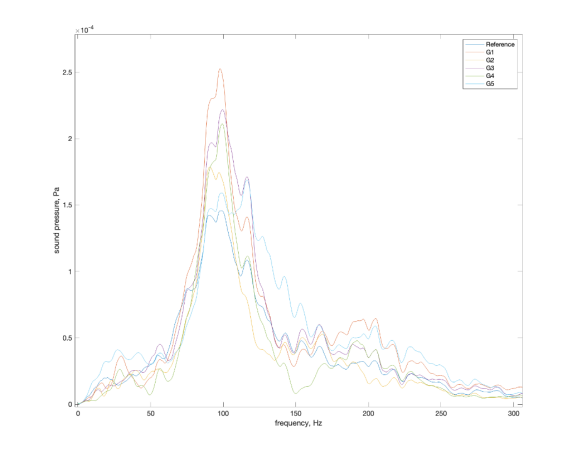
Figure 3.12: Comparison of the sound spectrum for a drum head with reduced thickness at the inner circle (G1 to G5 represent progressively larger inner diameter).
Similarly, the influence of the outer ring diameter with reduced thickness was examined, and the results are presented in Figure 3.13.
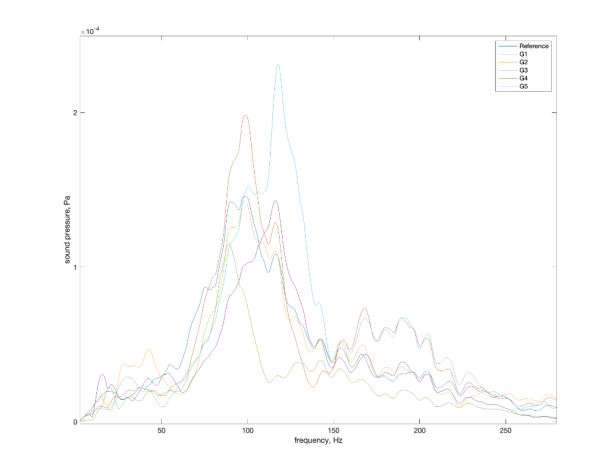
Figure 3.13: Comarison of the sound spectrum for a drum head with reduced thickness at the outer ring (G1 to G5 represent progressively larger outer ring thickness).
In Figure 3.13, the data from G4 is identified as an outlier and excluded from the analysis. The trend for the lower-frequency peak shows an initial increase followed by a decline, resembling the pattern seen when the inner circle thickness was reduced. The higher-frequency peak, though smaller, rises in amplitude. However, the close proximity of these peaks causes them to blend, altering the perceived frequency and potentially affecting sound quality.
When comparing the sound spectra of the inner circle and outer ring modifications, reducing the thickness in the inner circle generally yields a better result, as evidenced by a more prominent main peak.
For membranes with three different radii, the thickness was reduced proportionally, maintaining a consistent ratio of thinned radius to original radius across the groups. Figure 3.14 provides a comparison of the sound spectra from the outer ring modification.

Figure 3.14: Comparison of the sound spectrum for modified drum heads with different diameters (outer ring reduced in thickness).
The results indicate that as the thinned radius increases, the frequency of the main peak shifts to lower values due to the reduction in stiffness, making the membrane more prone to vibration. Specifically, the 40 cm diameter membrane exhibits a higher main peak with a larger amplitude, highlighting the relationship between the membrane’s size, stiffness, and vibration characteristics.
In this section, we found that the membrane's radius determines the vibration frequency, while its stiffness affects the acoustic properties, with lower stiffness making it easier to produce sound. While thinning different parts of the membrane can modify the sound quality, it is insufficient to create two distinct tones from a single strike. This is likely because thinning doesn't significantly alter the vibration modes and frequencies. Instead, the main effect of thinning is to enhance or modify the overall sound quality.
4.Conclusion
This work explores methods to improve drum sound quality and generate two distinct tones from a single strike. A theoretical model was developed linking sound production to membrane vibrations, where strike-induced vibrations alter air pressure, interacting with the drum’s structure and acoustic properties. By analyzing the membrane's diameter, density, and thickness, we established formulas to predict the drum’s sound frequencies.
Investigating drum size, head thickness, and pretension revealed that larger drums are harder to strike consistently, lowering repeatability. Material properties, especially damping, also affect repeatability, as higher damping causes faster energy dissipation. However, none of these factors alone could produce two distinct tones from a single strike, prompting further exploration of structural modifications, particularly varying the thickness of specific areas of the drum head.
Attempts to alter stiffness in specific membrane sections didn't split frequencies as intended. However, partial thickness modifications improved sound quality, enhancing the main peak and producing a purer tone. The increased first harmonic of the main peak also contributed to a richer timbre.
Looking ahead, several improvements can be made:
1.Using thicker drum heads would allow for more significant changes in thickness, potentially enabling the production of two distinct tones from a single strike.
2.Different striking positions trigger distinct vibration modes, suggesting that combining selective stiffness modifications with varied striking positions could help achieve the desired tonal effect.
3.The method of partially and uniformly altering membrane thickness offers promising potential for improving drum design and sound quality.
References
[1]. Bucur V. Handbook of materials for percussion musical instruments[M]. Springer Nature, 2022.
[2]. Toulson R. Drum sound and drum tuning: Bridging science and creativity[M]. Focal Press, 2021.
[3]. Rossing T D. Acoustical behavior of a bass drum[J]. The Journal of the Acoustical Society of America, 1987, 82(S1): S69-S69.
[4]. Fletcher H, Bassett I G. Quality of bass drum tones[J]. The Journal of the Acoustical Society of America, 1969, 45(1_Supplement): 313-314.
[5]. Fletcher H, Bassett I G. Some experiments with the bass drum[J]. The Journal of the Acoustical Society of America, 1978, 64(6): 1570-1576.
[6]. Crawford F. Can One Shape the Sound of a Drum?[J]. Mathematics Today, 2016: 280.
[7]. Nalyanya, Kallen & Rop, Ronald & Onyuka, Arthur & Odhiambo, Peter & Ngumbu, Richard. (2015). Thermal and mechanical analysis of pickled and tanned cowhide: Effect of solar radiations. Journal of Applied Polymer Science. 133. n/a-n/a. 10.1002/app.43208.
Cite this article
Lou,C. (2025). Exploring Drum Sound Quality and Dual-Tone Production Through Membrane Thickness Modifications. Theoretical and Natural Science,100,95-106.
Data availability
The datasets used and/or analyzed during the current study will be available from the authors upon reasonable request.
Disclaimer/Publisher's Note
The statements, opinions and data contained in all publications are solely those of the individual author(s) and contributor(s) and not of EWA Publishing and/or the editor(s). EWA Publishing and/or the editor(s) disclaim responsibility for any injury to people or property resulting from any ideas, methods, instructions or products referred to in the content.
About volume
Volume title: Proceedings of the 3rd International Conference on Mathematical Physics and Computational Simulation
© 2024 by the author(s). Licensee EWA Publishing, Oxford, UK. This article is an open access article distributed under the terms and
conditions of the Creative Commons Attribution (CC BY) license. Authors who
publish this series agree to the following terms:
1. Authors retain copyright and grant the series right of first publication with the work simultaneously licensed under a Creative Commons
Attribution License that allows others to share the work with an acknowledgment of the work's authorship and initial publication in this
series.
2. Authors are able to enter into separate, additional contractual arrangements for the non-exclusive distribution of the series's published
version of the work (e.g., post it to an institutional repository or publish it in a book), with an acknowledgment of its initial
publication in this series.
3. Authors are permitted and encouraged to post their work online (e.g., in institutional repositories or on their website) prior to and
during the submission process, as it can lead to productive exchanges, as well as earlier and greater citation of published work (See
Open access policy for details).
References
[1]. Bucur V. Handbook of materials for percussion musical instruments[M]. Springer Nature, 2022.
[2]. Toulson R. Drum sound and drum tuning: Bridging science and creativity[M]. Focal Press, 2021.
[3]. Rossing T D. Acoustical behavior of a bass drum[J]. The Journal of the Acoustical Society of America, 1987, 82(S1): S69-S69.
[4]. Fletcher H, Bassett I G. Quality of bass drum tones[J]. The Journal of the Acoustical Society of America, 1969, 45(1_Supplement): 313-314.
[5]. Fletcher H, Bassett I G. Some experiments with the bass drum[J]. The Journal of the Acoustical Society of America, 1978, 64(6): 1570-1576.
[6]. Crawford F. Can One Shape the Sound of a Drum?[J]. Mathematics Today, 2016: 280.
[7]. Nalyanya, Kallen & Rop, Ronald & Onyuka, Arthur & Odhiambo, Peter & Ngumbu, Richard. (2015). Thermal and mechanical analysis of pickled and tanned cowhide: Effect of solar radiations. Journal of Applied Polymer Science. 133. n/a-n/a. 10.1002/app.43208.










